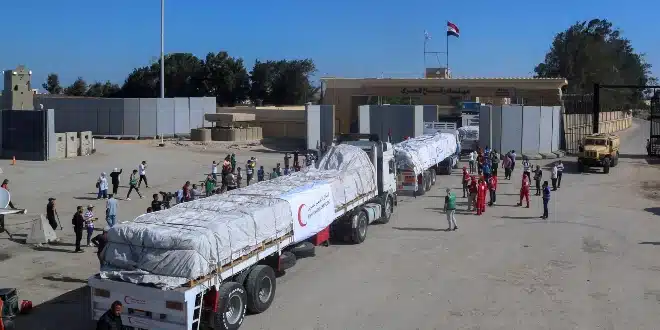Trucks carrying much-needed aid began moving into Gaza on Sunday, following Israel’s announcement of a temporary halt in military operations in select areas to facilitate relief efforts. Video footage from AFPTV captured the convoy’s movement from Egypt, marking a cautious step toward easing the dire humanitarian situation in the embattled enclave.
Although aid convoys initially gathered at Egypt’s Rafah border, the trucks were unable to directly enter Gaza due to the closure and damage to the Palestinian side of the crossing, which has been under Israeli control since last year. As a result, vehicles were rerouted several kilometers east to the Kerem Shalom (also known as Karam Abu Salem) crossing, a point of entry operated by Israel, where they underwent security checks before proceeding into southern Gaza.
Visuals from the Egyptian side of Rafah revealed large trucks loaded with white aid sacks. Some bore the emblem of the Egyptian Red Crescent, while others featured the United Arab Emirates’ flag and signage indicating support for water-related humanitarian initiatives in Gaza.
Israeli “Tactical Pause” Targets Humanitarian Access
In a move intended to facilitate humanitarian operations, the Israeli military announced a daily “tactical pause” between 10:00 a.m. and 8:00 p.m. in specific zones, including Al-Mawasi, Deir el-Balah, and certain sections of Gaza City. These areas are not currently active zones of Israeli military engagement.
According to the Israel Defense Forces (IDF), secure corridors were established throughout the Gaza Strip to enable aid convoys—particularly those operated by the United Nations and international relief agencies—to reach areas in need more effectively.
This announcement comes amid growing global pressure over the escalating humanitarian crisis in Gaza. Hunger and displacement have reached critical levels, prompting several nations—including the UAE and the United Kingdom—to initiate air-drops of food into the region. Israel has also joined in aerial aid delivery efforts.
Rising Criticism Over Aid Delivery Conditions
Despite these efforts, humanitarian organizations remain deeply concerned about the overall accessibility and safety of delivering aid on the ground. Philippe Lazzarini, Commissioner-General of the UN Relief and Works Agency for Palestine Refugees (UNRWA), voiced skepticism about the reliance on air-drops, describing them as “expensive, inefficient and potentially lethal” to civilians desperate for assistance.
Israel, on its part, maintains that it is not obstructing aid and places blame on some UN agencies for allegedly failing to distribute supplies already present in Gaza. However, multiple humanitarian groups argue that Israeli military operations and checkpoint procedures continue to impede safe and consistent delivery, particularly near distribution sites that are often volatile or under threat.
Further exacerbating tensions, Gaza’s civil defense authority reported on Saturday that over 50 Palestinians had been killed due to Israeli airstrikes and shootings—some of the victims were reportedly waiting near aid centers when they were targeted.
A Fragile Step Amid a Deepening Crisis
The renewed entry of aid trucks and the declaration of tactical pauses signal a tentative improvement in access, but they are overshadowed by continued violence and widespread suffering. With infrastructure heavily damaged and basic resources in short supply, humanitarian agencies stress that consistent and large-scale access—by land and under safe conditions—is the only viable path to alleviating Gaza’s escalating food insecurity.
As diplomatic and logistical efforts continue, the coming days will reveal whether these measures mark a turning point or merely offer a brief respite in a humanitarian catastrophe that shows no signs of easing.


